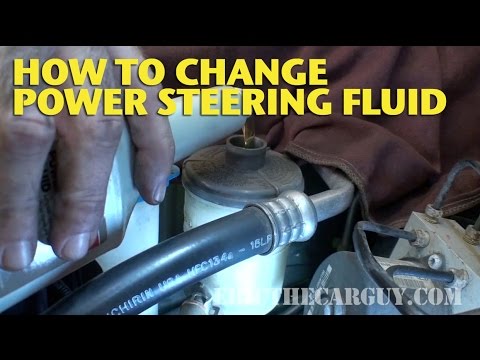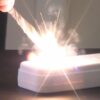I’ve been asked about doing a video on changing out power steering fluid for some time. I’ve finally put together this video to answer to that request. It’s really not that difficult. Figuring out some of the logistics however can be a challenge, but once you get past that it’s a pretty straightforward procedure. Just remember to use the correct fluid on your system. If not, it may not operate properly or damage to the power steering system can result.
Camera: Brian Kast
Useful links
Honda power steering fluid: http://www.carparts.com/details/Honda/S2000/OES_Genuine/Power_Steering_Fluid/2003/W0133-1639499.html?TID=80000000CP&origin=pla&CP=1&CP_SRC=PPC&003=27372932&010=cp15af6c01fafcfefeb4e72136cc77ccaa&c_aid=45534015333&c2cid=237927e1-b278-4bd7-938d-436de1d11706&gclid=CK-MxqCXssECFU8LMgodTWMAMA
Related videos.
How To Rebuild a Honda Power Steering Pump 98-02: https://www.youtube.com/watch?v=ArxN8T_6PbI
How To Check Fluids: https://www.youtube.com/watch?v=N5OTB_yU-h8
How To Change Brake Fluid: https://www.youtube.com/watch?v=V5O_pbC8R2E
How To Change Automatic Transmission Fluid Honda: https://www.youtube.com/watch?v=L7_RsnD8hAU
How To Change Honda Manual Transmission Fluid: https://www.youtube.com/watch?v=-Hl4utURDEU
How To Change Automatic Transmission Fluid Full Size GM: https://www.youtube.com/watch?v=Pmp_CTX5jsE
Changing Automatic Transmission Fluid 1997 Subaru (Part 1): https://www.youtube.com/watch?v=AVhXQti8Qv4
Changing Automatic Transmission Fluid 1997 Subaru (Part 2): https://www.youtube.com/watch?v=Lf4nRy6Zn_k
Changing Automatic Transmission Fluid 2004 Toyota 4Runner (Part 1): https://www.youtube.com/watch?v=HC57bKsW44k
Changing Automatic Transmission Fluid 2004 Toyota 4Runner (Part 2): https://www.youtube.com/watch?v=yv8BwggCfuQ
Useful Articles.
Electrical Problems
http://www.ericthecarguy.com/faq/solving-automotive-electrical-problems
Engine overheat
http://www.ericthecarguy.com/faq/what-to-do-when-your-engine-overheats
No start problems
http://www.ericthecarguy.com/faq/solving-automotive-no-start-problems
Idle issues
http://www.ericthecarguy.com/faq/solving-automotive-idle-problems
Performance issues
http://www.ericthecarguy.com/faq/solving-automotive-performance-issues
Diagnosing Noises
http://www.ericthecarguy.com/faq/diagnosing-noises-in-your-car
Diagnosing Vibrations
http://www.ericthecarguy.com/faq/determining-the-causes-of-vehicle-vibrations
Brake Issues
http://www.ericthecarguy.com/faq/solving-brake-problems
Transmission issues
http://www.ericthecarguy.com/faq/solving-transmission-problems
HVAC problems
http://www.ericthecarguy.com/faq/solving-automotive-hvac-problems
Buying a Used Car
http://www.ericthecarguy.com/faq/what-to-look-for-in-a-used-car-purchase
Leaks
http://www.ericthecarguy.com/faq/finding-and-fixing-leaks
MPG
http://ericthecarguy.com/faq/finding-and-fixing-the-causes-of-poor-mpg
Discussion about this Video: http://www.ericthecarguy.com/kunena/18-The-EricTheCarGuy-Video-Forum/54594-how-to-change-power-steering-fluid#117830
ETCG Forum: http://www.ericthecarguy.com/component/kunena/1-stay-dirty-lounge?Itemid=0
Facebook: https://www.facebook.com/EricTheCarGuy?fref=ts
Twitter: https://twitter.com/EricTheCarGuy
Google+: https://plus.google.com/100195180196698058780/posts
Information on Premium Membership: http://www.ericthecarguy.com/premium-content-streaming-etcg-content
Stay Dirty
ETCG
Due to factors beyond the control of EricTheCarGuy, it cannot guarantee against unauthorized modifications of this information, or improper use of this information. EricTheCarGuy assumes no liability for property damage or injury incurred as a result of any of the information contained in this video. EricTheCarGuy recommends safe practices when working with power tools, automotive lifts, lifting tools, jack stands, electrical equipment, blunt instruments, chemicals, lubricants, or any other tools or equipment seen or implied in this video. Due to factors beyond the control of EricTheCarGuy, no information contained in this video shall create any express or implied warranty or guarantee of any particular result. Any injury, damage or loss that may result from improper use of these tools, equipment, or the information contained in this video is the sole responsibility of the user and not EricTheCarGuy.





















The power steering pump should never run empty!!!!!!
Learn the mechanics of genius.!!!
Comment after comment about running the pump dry. For the armchair mechanics here, try reading the Honda service manual, and you'll see that his procedure is exactly how they recommend doing it.
My 2000 Ford Windstar sucks the tank dry faster than I can shut it off if I crank it to turn the wheel lock to lock.
Everybody else says to jack up the front wheels and turn the steering wheel but NOT to run the engine, or just to run it for a few seconds, otherwise you can damage the pump if it runs dry.
How many bottles should I need for my accord ex v6 ?
You didn't add a ATF?
I used a plastic bag around (below) any fitting that I’m going to disconnect. No worry about getting fluid on the ground or on any surface in the engine area. Limits any unneeded cleanup. Furthermore, I would never introduce air into a steering system. The MANUAL way…. Remove pump return line off the power steering reservoir. Next block off the return port on the reservoir. This allows you to use the reservoir to supply clean fluid to the pump. I used a short piece of clear plastic hose with one end bent back with a clamp. You can also install a bolt into that hose end. This hose will be installed on the reservoir return connection. The pump return hose is connected via a barb connection to another hose leading into a waste container. It can be done without starting the vehicle. Fill reservoir and turn steering wheel all the way one direction and back the full other way. The call the Block to Block. Do it a couple times. Fill reservoir again. Redo previous step of turning steering wheel full travel again. R to L L to R. You will notice clean fluid will start to push out the old fluid. It removed it all from the steering rack, pump and all system hoses. Keep doing this procedure of topping off of reservoir fluid and turning the steering wheel full travel. Once there is clean fluid noticeable going to waste container- STOP 🛑. Next reinstall the pump return hose to the fluid reservoir. Check fluid level. Start vehicle. Turn wheel block to block. Any air if any will be removed. Recheck reservoir and systems for any leaks. EASY JOB!!!
This method runs the pump and rack dry and introduces air bubbles after refilling. Better is to not let the reservoir go empty but keep filling it as it is emptied. Pumping the fluid out just by turning the wheel but without turning the car on is the safest way to go.
Super helpful, thank you so much!
You're a great teacher. Thanks.
Good video but you forgot yo clean the powersteering recervor it has a filter inside.
My 250K Element is totally out of power steering fluid, the reservoir is also very dirty on the inside. Should I worry about cleaning it out? I was planning to just remove it, clean it out with degreaser and reinstall. Whatcha think?
how often to change. I suck out the reserviour every oil change (every 3000 miles) and fill with fresh fluid. In 2 to 4 oil changes its practaly new fluid.
I watched this in 2014 .
Gr8 vid, I did a 3x drain reservoir & fill procedure instead for a Nissan Maxima. However on that car. it uses ATF fluid (matic-D) instead of power steering fluid.
This is great to know of another way to do this.
You made your poor pump running dry!
Letting the pump run dry is a great way to damage it….I would not recommend this at all
Do you have to run the engine to drain the system? I saw a video where the guy turned the wheel stop to stop, engine off, with the wheels off the ground and drained it through the return line as you did.
And the O ring? or does this model not have an O ring?
I know this is 6 years old, but that serpentine belt looks like it should be retired. My '04 was ready for one in 2012.
Not good enough procedure.
Thank you for showing me how to do that. I have a 06 E and have a power steering leak. I was going to start replacing O rings one by one to see if that will stop the leak. Any suggestions on that?
If you think about it fully, you are unlikely to cause any damage to the PS pump because in flushing out the fluid you will see all the fluid is out of the system pretty quickly.
You will notice the change in the noise the PS pump makes when it has pumped all the fluid out of the system. The noise the pump will make will be hardly perceptible, but it will nevertheless be there.
Obviously, damage to the pump can only occur when it gets hot, (with no fluid in the system to lubricate it).
Since you will not be running the engine / PS pump for that long without fluid in the system it is not going to get hot.
The likely running time is only going to be seconds and not minutes. It will be determined by your observing the fluid as it drains out…..and seeing that it is all out….. possibly with the slight change in the noise from the PS pump….
So, as I stated above…seconds..
The use of a clear plastic hose may help in determining that all the old fluid is out of the system, since you will be able to see the fluid flowing.
Since you have no need to turn the steering as the system empties….and is then empty…..you will not be giving the steering mechanism any work to do that could possibly damage it.
Turning the steering to bleed air when the new fluid is in will obviously not be damaging on any way……and the principle of letting air rise….and then dissipate from the PS reservoir, (leave the cap off about ten minutes, maybe less), is a good idea.
You will see the fluid in the PS reservoir is air bubble free before you put the cap back on..
There is merit in cleaning the surface of the PS reservoir before you start work….and obviously afterwards also.
There is also something to be said for removing the PS reservoir completely in order to give it a through cleaning to the inside of it…
This can be done when the system had been drained and will ensure there are no contaminants on the inside walls of the PS reservoir itself…
Obviously, doing this will add another five or ten minutes to the job…..and might not be thought to be necessary.
But if you have hoses disconnected and the system drained there is no better time to disconnect and thoroughly clean the PS reservoir…..if you want to do so.
James Hennighan
Yorkshire, England
Think fluid equals lubrication and therefore no heat damage and you won't go wrong
You don’t need to start the car just jack it up and turn the steering from lock to lock
what where you thinking man? the whole idea is maintenance …not grinding the pump to a metal pulp by running it dry ..
Well done mate really straightforward instructions 👍
a spark plug is a plug nonetheless
How critical is it to use ONLY Honda ps fluid? Or will regular fluid be fine? Thanks
Wow, listen to that pump whine when he starts it up.
Strange the pump suction line to the pump is routed up over the drive belt then down into the pump.
Didn't u run the pump dry?
I bought one of those extractors that are hand pumped, made it so much easier and no mess at all. I spent $45 for it.
Is that hard on the power steering pump being run dry?
Hello, can/should I replace with an aftermarket reservoir for Honda, like Dorman? Thanks.
you are not a smart guy….
July 30, 2020 YOUR VIDEO IS NOT GOOD; IT IS TERRIBLE.
DO NOT SHOW THE AMOUNT OF OIL THAT COMES OUT.
DO NOT SHOW HOSE DISCONNECT AND RECONNECT HOSES.
DO NOT SHOW THE WAY YOU CORRECT THE NOISE OF THE BLENDER OR HYDRAULIC STEERING PUMP.
‼️ IT IS TERRIBLE YOUR VIDEO ‼️
I don't think brake cleaner should be sprayed all over hoses and plastic parts.
Great idea for a Honda yearly, cheap preventive maintenance.
Too bad you did it wrong.
Never run the power steering pump dry!
Use this method https://youtu.be/ZzEIIGZwNG4
Fuck you Erik
Great
I did this yeasterday and one hint I can give you is to jack up your car, it will be more easy to turn the wheel lock to lock
Eric do you have experience working on a Nissan I really hate them but my niece has one and I have some issues that need to be resolved ASAP on a 2013 Sentra (pure drive) transmission
How many bottles did you use?
2003 ssturn Ions have no power steering resevoir. It's an electrical system. A motor is controlled by a fuse. If defective the $257.00 garage charge covered by GM according Saturn Forum. Mine is fine, but steering wheel squeaks. I'm a DIY'er and I live by the maxim: "a man must know his limitations".
There is no way I'm tearing apart a steering wheel column to correct a squeak. I use ZEN and just pretend that irritant isn't there.
Or, at most, zap the column (but where?) with WD40 or silicone….at most.
David
Alberta
I replaced a hose, used autozone fluid, noisy as hell. Now i've just started sucking out some of the old fluid and using Honda, it's already quieter and i'm not even close to done yet.
Fuck off… Don't show Ur face, go straight to engine portion
I can’t believe running that pump dry is ever a good idea. I simple use a turkey baster to suck all the fluid out of the reservoir. Refill and then drive the car. Do this every 2nd or 3rd oil change and the fluid never gets dirty in the first place. If your power steering fluid is already dirty, do this three times over a few days. Use OEM power steering fluid.